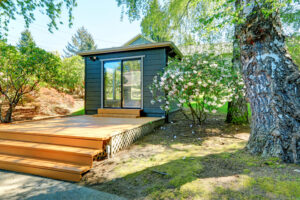
Despite the unpredictable British weather, we do, as a nation love to be out in the garden. From pottering around in the borders, to cooking up a storm on the BBQ and making the most of the sometimes-shy sunshine with friends and family. One garden trend that has increased in popularity over the last couple of years is adding a garden room. These can be opened up to get the best of the sunny weather, but should the weather take a turn for the worse you can batten down the hatches, keep warm and dry and still enjoy being outside. In this article we will take a look at some garden room options and highlight some of the things you might need to consider.

Do you need planning permission for a garden room?
First and foremost, you will need to know whether you will need planning permission for your garden room. Garden rooms are typically considered permitted developments but there are planning rules which mean that in some circumstances you might need permission from your local planning office. Those circumstances are:
- If your home is listed or in a conservation area. If either of these apply to your property, you might not have permitted development rights.
- The new garden room is to be situated in the front of your home. If you have extended the property then the front refers to how it stood on 1 July 1948 if it was built before then or the front as it was first built.
- The total area of all extensions, sheds and outbuildings – including your proposed garden room – covers more than 50% of the total area of land around your house. Again, the definition of this is the area as it was on 1 July 1948 if it was built before then or the area when it was first built if after that was after this date.
- If the proposed garden room, as a single storey, exceeds 3 metres high (4 metres with a dual-pitched roof). If it is to be situated within 2 metres of your boundary, the height restriction for permitted developments is 2.5 metres.
- The garden room eaves will be more than 2.5 metres above ground level.
- If the garden room will have a balcony, veranda or raised platform.
- If it will be self-contained living accommodation.
If any of the above are true, then you will most likely have to go through the planning permission process. If in doubt check with your local planning office.
Siting your garden room
As you get to grips with the legal side of your project, you will also need to decide on where the garden room is going to be sited. There are a number of other factors to consider when deciding on where your garden room should go. Some of these decisions might include options like:
Use – think about what you will be using this new space for. Will it be a place of peace and tranquillity, a home bar, a cinema room, a gym, a home office, a playroom or any combination of the above. Once you decide how you will be using your new room, some of the other decisions are easier to make.
Orientation – which way the windows/doors will face, south for sun worshipers or does it make more sense to have the glass side looking over a particular areas of the garden or facing the house? Or should the windowed area of the garden room be set out of neighbour’s view?
Accessibility – is there, or can a path to the garden room be sensibly created? Do you want it attached to your house like a conservatory or do you want a standalone building further into the garden? There are pros and cons for each option. Attaching the room to your home will make it easier to install an electricity supply, water or other utility supplies.
Amenities – will you need electricity, heating, running water or an internet connection/phone line in your garden room? Check to make sure these are feasible with the garden room set in your chosen location.
Risks – assess your chosen area for risks. Try to choose a place away from large trees, this will avoid the risk of tree roots interfering with your garden room in years to come.
What style garden room to choose
Garden rooms come in lots of different shapes and sizes. Some arrive in kit form for you to construct and others are supplied and installed by the retailer. If your DIY skills aren’t quite up to designing and building your own garden room, you’ll be pleased to hear that you can buy readymade ones. Here are a few style suggestions for you to consider:
Lots of Light – this contemporary “studio Flat” from the Greenhouse people, with glass to ground double glazed windows either side of the double glazed double doors, will allow light to flood in at almost any time of the day.
Corner Design – If you are looking for something to fit snuggly into an unused corner of your garden, then this corner studio design could be a good choice.
Big is beautiful – If you have plenty of space this Concave Garden room from Modern Garden rooms is a real contender. With inbuilt sockets and heating, it also comes with external decking which is ideal for sunbathing and entertaining.
Storage space – this Hansa Lounge option from Summer House has two separate rooms. A large living space and a smaller built-in storage shed. Now that could come in handy!
Garden rooms can be a lovely addition to your garden, solving the perennial issue of the British weather taking a sudden turn for the worse and rain stopping play. So, choose your spot, choose your room and start making the most of your garden, whatever the weather.



